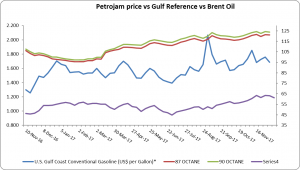Brent Oil
Brent oil prices declined by 2.99% (US$1.89), as prices declined this week. Oil traded on December 07, 2017 at a price of 61.22 (US$ barrel) and began the year at US$56.0 per barrel.
Petrojam prices
87 Octane prices declined week over week, by 0.29% (US$0.35 ). Additionally 90 Octane declined by 0.28% or $0.35 week over week. 87 Octane and 90 Octane opened the year at J$97.32 and J$98.98 respectively and now trades at J$121.02 and J$123.86 per litre.

Figure 1: Petrojam, U.S. Gulf Coast Conventional Gasoline Regular and Brent Crude Oil 1 Year Price History
This Week in Petroleum
Monthly Midwest crude oil imports surpassed Gulf Coast crude oil imports for first time
In August, monthly U.S. imports of crude oil coming into the Midwest (Petroleum Administrative Defense District (PADD) 2) exceeded imports of crude oil into the Gulf Coast (PADD 3) for the first time since the U.S. Energy Information Administration began keeping records in 1981. Although Hurricane Harvey disrupting Gulf Coast port operations and temporarily limiting imports was a primary factor in this reversal, which continued in September, other long-term trends contributed as well. Specifically, imports of crude oil into the Gulf Coast have been decreasing over the past 10 years, and imports into the Midwest have been increasing over the same period. These long-term trends narrowed the difference in imports between the two regions and contributed to the reversal in the historical relationship after Hurricane Harvey.
The long-term increases of crude oil availability in the Midwest from domestic and Canadian sources have led to evolving trade and supply patterns, both domestically and internationally. Historically, the Midwest received crude oil from the Gulf Coast, including both domestically produced crude oil and imports that were received by ports in the Gulf Coast, then sent via pipeline to the Midwest for processing. Despite increasing gross inputs into refineries, the Midwest has reduced its reliance on both domestic crude oil shipments and foreign imports sent from the Gulf Coast, while imports into the Midwest from Canada have increased.
As U.S. crude oil production has increased, foreign crude oil imports have decreased. Total U.S. crude oil imports fell from 10.1 million barrels per day (b/d) in 2005 to 7.9 million b/d in 2016. However, from 2005 to 2016, imports from Canada (the largest single supplier of crude oil to the United States) grew from 1.6 million b/d to 3.2 million b/d, while imports from Saudi Arabia (the second-largest source of U.S. crude oil imports) fell from 1.4 million b/d to 1.1 million b/d. Most of the crude oil imports from Canada are processed in Midwest refineries, while most of the Saudi imports are processed in Gulf Coast refineries.
https://www.eia.gov/petroleum/weekly/
